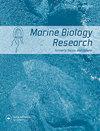First evidence of trace metals and persistent organic contaminants from an endangered marine species, Mobula mobular (Bonattere, 1788) caught in Hellenic waters (Saronikos Gulf)
IF 1.2
4区 生物学
Q4 ECOLOGY
引用次数: 0
Abstract
ABSTRACTThe number of cartilaginous fish is declining worldwide and contaminants are one of the primary stress factors in marine organisms. The spinetail devil ray or giant devil ray (Mobula mobular) is listed as an ‘Endangered species’ globally in the IUCN Red List of Threatened Species. One individual devil ray caught in Saronikos Gulf was tested for trace metals (Zn, Cu, Fe, Mn, Ni, Cr, Pb and Hg) and organochlorine contaminants (PCBs and DDTs). The concentrations of contaminants in the muscle tissue of the devil ray did not exceed safe human consumption limits. However, relatively elevated levels of trace metals and PCBs were measured in the liver and in particular the PCB congeners were five times higher than the European Commission limit. This study highlights the need for future research on the potential impacts of trace metals and organic contaminants on elasmobranchs and more specifically on threatened species.KEYWORDS: Spinetail devil raytrace metalsDDTsPCBsSaronikos Gulf AcknowledgementsThe authors would like to thank Elvira Plakidi and Stella Chourdaki from the Organic Chemistry Laboratory of the Hellenic Center for Marine Research – Institute of Oceanography for their help and kind advice in measuring organochlorine substances and Chryssa Roka for preparing the map.Disclosure statementNo potential conflict of interest was reported by the authors.在希腊水域(萨罗尼科斯湾)捕获的一种濒危海洋物种——摩布拉(Bonattere, 1788)中首次发现微量金属和持久性有机污染物的证据。
摘要在世界范围内,软骨鱼类的数量正在减少,污染物是海洋生物的主要胁迫因素之一。棘尾魔鬼鳐或巨型魔鬼鳐(Mobula mobular)在世界自然保护联盟(IUCN)濒危物种红色名录中被列为“濒危物种”。在萨罗尼科斯湾捕获的一条魔鬼鱼进行了微量金属(锌、铜、铁、锰、镍、铬、铅和汞)和有机氯污染物(多氯联苯和滴滴涕)的检测。魔鬼鱼肌肉组织中污染物的浓度没有超过人类食用的安全限度。然而,肝脏中微量金属和多氯联苯的含量相对较高,特别是多氯联苯同系物的含量比欧盟委员会的限值高出5倍。该研究强调了微量金属和有机污染物对板鳃类,特别是受威胁物种的潜在影响的进一步研究的必要性。作者要感谢希腊海洋研究所海洋研究中心有机化学实验室的Elvira Plakidi和Stella Chourdaki在测量有机氯物质方面提供的帮助和友好建议,并感谢Chryssa Roka为绘制该地图所做的工作。披露声明作者未报告潜在的利益冲突。
本文章由计算机程序翻译,如有差异,请以英文原文为准。
求助全文
约1分钟内获得全文
求助全文
来源期刊

Marine Biology Research
生物-海洋与淡水生物学
CiteScore
2.10
自引率
0.00%
发文量
55
审稿时长
6-12 weeks
期刊介绍:
Marine Biology Research (MBRJ) provides a worldwide forum for key information, ideas and discussion on all areas of marine biology and biological oceanography. Founded in 2005 as a merger of two Scandinavian journals, Sarsia and Ophelia, MBRJ is based today at the Institute of Marine Research, Bergen, Norway. The Journal’s scope encompasses basic and applied research from all oceans and marine habitats and on all marine organisms, the main criterium for acceptance being quality.
 求助内容:
求助内容: 应助结果提醒方式:
应助结果提醒方式:


